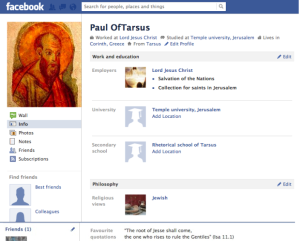Religious authority and social media: old wine in new bags?

The Protestant Church in the Netherlands recently added a ‘social media guide for ministers and pastoral workers’ to its professional code. The guide encourages the use of social media like Facebook and Twitter as a communication channel, acknowledging its potential to reach new audiences. But it also highlights certain risks – in particular, the difficulty of maintaining an online identity that supports a church official’s professional credibility and authority. Social media tend to blur the line between personal and professional personas, but ‘a minister carries his or her office 24 hours a day’.
Projecting an appropriate online identity is also a concern for non-religious professional groups, including politicians, police officers and teachers, whose professional authority is traditionally embodied in their office, and less in their personality. The development of social media guides fit into a wider trend of increasing anxiety about how social media has affected society. The committee charged with the investigation of the Haren riots (still described as ‘the Facebook party’), for example, is specifically looking into the role of social media in inciting the violence.
But I wonder, do we sometimes exaggerate the radical changes brought about by Facebook and Twitter? Yes, the internet certainly challenges traditional political, social and religious authorities as it transforms communication: it creates new sources of power by providing new platforms to voices that would otherwise not be heard, and flattens traditional hierarchies [1]. But concerns about how to establish credibility and authority by remote means are by no means new.
Let’s take a look at one of the ways in which religious authority could be exercised in the pre-internet era. I focus on the apostle Paul and the letters he wrote to the religious communities he had founded in the first-century Mediterranean. He used these letters to encourage, instruct and, when necessary, reprimand people over whom he a felt a fatherly authority (nowadays he has something of a reputation as a moralising grouch, but that’s another story!).
Paul also wrote a long letter to the followers of Christ in the city of Rome – a group of people with whom he does not appear to have had any previous dealings. He expresses his wish to visit them soon to gain support for his plans to bring the gospel to the unexplored territories of Spain (Romans 15.17- 33), and provides instructions on how to give shape to their new religious life. But, unlike in his other letters, Paul does not enjoy a natural authority as founding father of this community. That means that he has to make an extra effort to convince them of his authority, credibility and trustworthiness.
Paul’s challenge is not all that dissimilar to that of church officials struggling to present an appropriate online identity. And the way he attempts to do it is also very familiar to those of us in a social media age. He starts, in the opening phrases of his letter, by carefully constructing an image of himself as the apostle sent by God to the nations, and includes his Roman audience in this target group (Romans1.1-7). This is like his profile page, where he gives strategic information in support of the image he wants to present – his interests, places he has been, his favourite quotations from the Hebrew bible, and his identity as God’s envoy to the nations.
But why should readers believe him? He needs some form of external verification – and this he gets in another very familiar way. He ends the letter by greeting 26 people he knows in Rome. This is highly unusual – it is the longest greeting list that has been preserved among ancient letters, and a clear breach of epistolary convention (Romans 16.3-21). It makes sense, however, if we regard it in the light of a list of ‘friends’ on Facebook, ‘followers’ on Twitter, or ‘endorsers’ on Linked-In.
We know from studies of social network sites such as Facebook that having a large number of online friends has a signalling value [3]. Such connections are taken as verification of the persona presented online – as if your friends are ‘vouching’ for the accuracy of the information presented. Showing your connections also provides further information about the circles you move in, and, by extension, about yourself. Having mutual acquaintances creates trust by association.
In the same way, Paul’s name-dropping serves to support the authoritative persona he presents in the opening of his letter. This public display of connection shows Paul in the context of his Roman connections, gaining him trust by association and helping to validate his self-presentation as a religious authority. And Paul is also ‘networking’ – calling on his named ‘contacts’ in Rome to mobilise their social capital and their resources.
This perspective may suggest that social media sometimes gains too much credit for radically altering the way in which authority and credibility is constructed. Its potential reach is unprecedented, but the strategies and concerns of self-presentation, credibility, and trust are not dissimilar. Or does it rather reveal me as a product of the internet era and confirm the transformative effects social media has, even on the way in which we do historical research?
Birgit van der Lans is a PhD student at the Faculty of Theology and Religious Studies, working on the historical setting of Paul’s letter to Rome.
[1] H. Campbell and P. Neusner, ‘Religious Authority in the Age of the Internet’, in: R. Kruschwitz (ed.), Virtual Lives (Waco, TX: The Center for Christian Ethics at Baylor University, 2011) 59-68.(http://www.baylor.edu/content/services/document.php/130950.pdf).
[2] J.Donath and d.boyd, ‘Public Displays of Connection’, BT Technology Journal 22 (2004) 71-82.
[3] J.Donath and d.boyd, ‘Public Displays of Connection’, BT Technology Journal 22 (2004) 71-82.

